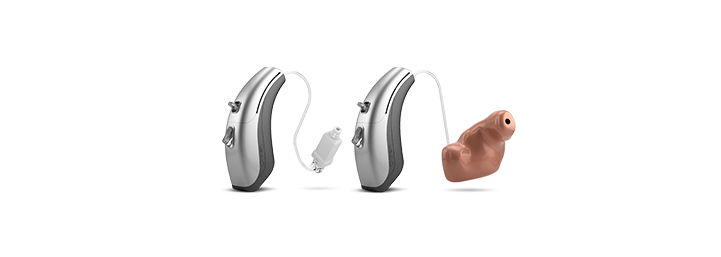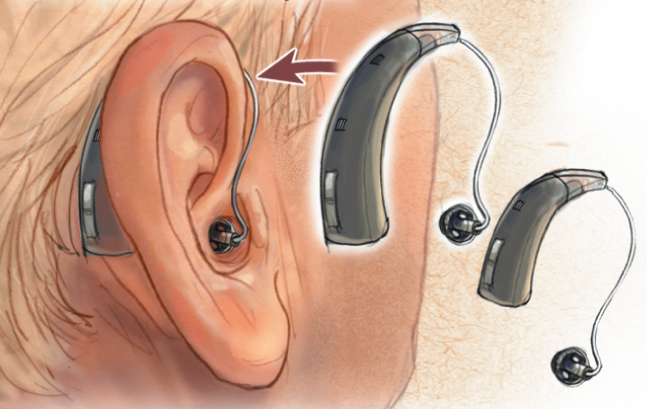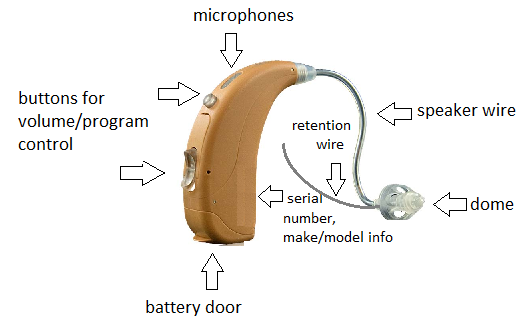Receiver-in-canal RIC, or Receiver in the ear (RITE) hearing aids are worn behind the ear and come with tiny housings. As their receiver sits directly in the ear canal. The so-called mini receivers come in different sizes for different levels of amplification. RICs can be quickly and easily adjusted and provide a high degree of wearing comfort, discretion, and appropriate amplification.
You can purchase the latest hearing aids at a fair price through HearingSol, If you need any assistance or you have a query regarding Receiver-in-canal (RIC) Hearing Aid or Hearing Loss, feel free to call us at +91-9327901950. We are always here to help you.
Here the microphone and receiver are not put in the same container. Thus it leads to the prevention of vibration generated feedback or whistling.
The RIC’s loudspeaker or “receiver” is located outside the housing and positioned at the end of the thin ear wire, placed near the eardrum. Since generated sound only has to travel a very short distance with lower transmission loss. So, it requires less sound energy (and battery power) to produce a superior listening experience.
Is RIC Hearing Aid Different From RITE?

RIC and RITE are wired receiver hearing aids where the receiver is at the end of the wire and is placed in a position in the ear. Thus RIC devices are also known as RITE hearing aids. Though they have similar models and features they are different from each other due to their placement of the receiver. Different hearing aids manufacturers sometimes call RIC or RITE hearing devices. And some call them somewhat different from each other.
RICs and RITEs are pretty much the same styles of devices just named differently by different hearing aid manufacturers. According to Widex, in the case of Receiver in the canal (RIC), the receiver of the hearing machine (the white thing at the end of the wire) goes into your ear canal. But in Receiver in the ear (RITE) hearing aids, the receiver actually lives in the portion of the earmold that sits in the outer ear. A sound tube runs from that receiver along the inside of the piece that goes into your ear canal.
Thus, they are just named differently by different manufacturers in most cases (but in others, they aren’t!) hearing aid companies and their confusing designations.
RIC, RITE Hearing Aid Features

RIC hearing aid separates the components into two major sections. A case behind the ear holds the aid’s amplifier and microphone, while a small bud that contains the receiver is used inside the ear canal. A small tube connects the receiver to the case. They are smaller than standard BTE models, but are easy to maneuver and can still house a variety of features.
The latest technology is used in RIC is available such as the wireless connectivity feature and provides a level of comfort that is taking today’s RIC devices to new heights of popularity among users.
RIC hearing aids house either a size 10 (Yellow), size 312 (Brown), or size 13 (Orange) battery depending on the style and size selected. The typical lifespan of a size 10 battery is between 3-5 days, size 312 battery between 5-7 days, and size 13 battery between 10-14 days. This can vary depending upon the number of hours per day the ear machine is worn, the severity of hearing loss, and the technology level of hearing aid.
You may observe the following features
- Available in mini or micro sizes
- All components except receiver contained in a case worn behind the ear
- Sound directed into the ear canal through the receiver unit
- Can be fitted with standard domes or custom earmolds
- Virtually unnoticeable when worn
- For mild to severe hearing losses
- Variety of color options available
- It possesses a discreet design and is more invisible than IIC and CIC hearing aids.
- It is easy to adjust as well as in handling.
RIC, RITE Hearing Aid Advantages

RICs are a type of open-fit device that uses a thin plastic “micro” tube that extends from the body of the hearing aid (housed behind the ear) over the outer ear and into the ear canal. A small, soft tip sits inside the ear canal without sealing it. This way, air and sound can continue to flow to the ear canal naturally, reducing feelings of being “plugged up”.
Feedback and occlusion tend to be much less of a problem with RIC devices than they are with other hearing aids.
With the ear canal open, wearers generally report a more natural sound which is judged to be more comfortable. As the receiver is located inside the ear canal, it gives more natural and crispy sound quality.
This type of device is a great choice for listeners with mild to moderate hearing issues because it amplifies high-pitched tones exceptionally well. If your loss is in the mild to the moderately severe range and you have the ability to manipulate small objects, these hearing machines may be a good option for you.
The RIC provides the facility to change the power levels. This means you may use it without replacing it if your hearing deteriorates in the future.
You may enjoy the following benefits:
- Minimizes sounds of your own voice by allowing sounds to escape the ear canal
- Small, virtually unnoticeable casings
- Nearly invisible tubing
- Larger batteries for longer battery life
- Even suitable for profound hearing losses due to the different power receiver levels.
- Different ear domes can be fitted to the receiver inside the ear making them suitable for a variety of types of hearing losses.
- Dual-microphones help to improve speech understanding in noise.
- It is available in both wireless as well as telecoil options.
RIC, RITE Hearing Aid Disadvantages
Frequent repairs to the receiver are one drawback to the receiver in the canal because the receiver end is vulnerable to moisture in the ear canal.
The aid has less intrusive placement than other hearing aid styles means it can be easy to lose them and not notice.
Amazingly, the potential for loss is another drawback. Because they are so small and lightweight it can take some time for the user to realize that the hearing machine is missing.
Compared to other hearing aid styles, the receiver in canal designs is average to above average in cost.
If you have manual dexterity and reduced vision, then Receiver in canal (RIC) hearing aids may not be appropriate for you.
Dead skin from behind the ear may damage your microphone. Thus it needs proper maintenance and cleaning.
There is a loss of natural acoustics that the external ear provides and helps with localizing the direction of sound from in front and behind you.
You need to hold the telephone receiver in a slightly unnatural position over the top of the ear next to the hearing aid microphone.
How Much Do RIC or RITE Hearing Aids Cost?
The price of standard RIC may vary as per different models and companies. It ranges from approx. Rs.25000 per unit up to Rs. 250000 per unit. Mostly hearing machine manufacturers provide a variety of Receiver in canal (RIC).
If you are planning to buy a RIC hearing aid, buy it at a fair price from HearingSol, and if you are an Indian, you can also check out the cost of the hearing aids in India.
To get any type of consultation or advice you can book an appointment or call our toll-free number +91-9327901950 where our hearing specialist will help you in all ways.

